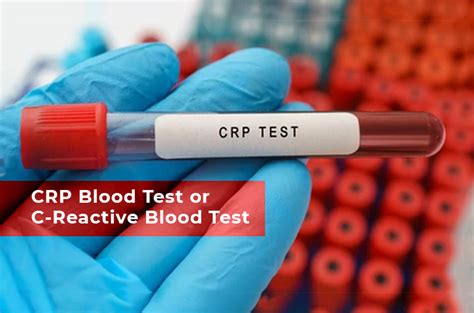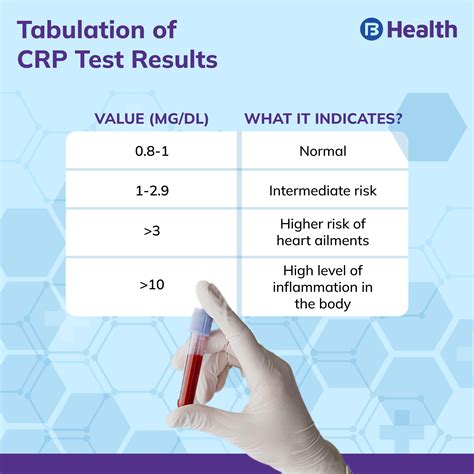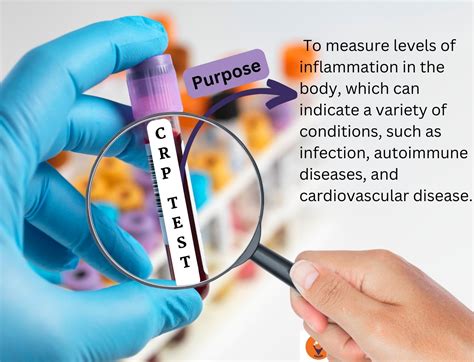Intro
Unlock the secrets of CRP blood investigation with our comprehensive guide, covering C-Reactive Protein tests, inflammation markers, and diagnostic procedures to help you understand blood work results and manage health conditions effectively.
The C-Reactive Protein (CRP) blood test is a widely used diagnostic tool that helps healthcare professionals assess the level of inflammation in the body. Inflammation is a natural response of the immune system to injury or infection, but chronic inflammation can be a sign of underlying conditions such as arthritis, diabetes, or cardiovascular disease. Understanding the CRP blood test and its implications is essential for healthcare providers and patients alike. In this article, we will delve into the world of CRP blood investigation, exploring its benefits, working mechanisms, and practical applications.
CRP is an acute-phase protein that is produced by the liver in response to inflammation. The level of CRP in the blood increases rapidly in response to inflammation, making it a valuable marker for detecting and monitoring various conditions. The CRP blood test is often used in conjunction with other diagnostic tests, such as the erythrocyte sedimentation rate (ESR) test, to provide a comprehensive picture of a patient's inflammatory status. By understanding the results of the CRP blood test, healthcare providers can develop effective treatment plans and monitor the progression of diseases.
The CRP blood test has numerous benefits, including its high sensitivity and specificity, making it a reliable diagnostic tool. The test is also relatively inexpensive and can be performed quickly, making it a valuable resource for healthcare providers. Furthermore, the CRP blood test can be used to monitor the effectiveness of treatments and adjust them as needed. For example, if a patient is being treated for rheumatoid arthritis, the CRP blood test can be used to assess the level of inflammation and adjust the treatment plan accordingly.
Introduction to CRP Blood Investigation

How CRP Blood Investigation Works
The CRP blood test works by measuring the level of CRP in the blood. CRP is produced by the liver in response to inflammation, and its level increases rapidly in response to inflammatory stimuli. The test is based on the principle that CRP binds to phosphocholine, a molecule that is exposed on the surface of dead or dying cells. The binding of CRP to phosphocholine activates the complement system, which helps to eliminate pathogens and damaged cells from the body. By measuring the level of CRP in the blood, healthcare providers can assess the level of inflammation and develop effective treatment plans.Benefits of CRP Blood Investigation

Practical Applications of CRP Blood Investigation
The CRP blood test has numerous practical applications in clinical medicine. Some of the most common uses of the test include: * Diagnosing and monitoring inflammatory conditions such as rheumatoid arthritis, lupus, and Crohn's disease * Assessing the risk of cardiovascular disease * Monitoring the effectiveness of treatments for inflammatory conditions * Diagnosing and monitoring infections such as pneumonia and sepsis * Assessing the level of inflammation in patients with cancerSteps Involved in CRP Blood Investigation

Interpreting CRP Blood Investigation Results
The results of the CRP blood test are typically reported in milligrams per liter (mg/L) or milligrams per deciliter (mg/dL). A high level of CRP in the blood indicates inflammation, while a low level suggests that the patient is not experiencing significant inflammation. The following are some general guidelines for interpreting CRP blood test results: * Normal: Less than 10 mg/L * Elevated: 10-50 mg/L * High: 50-100 mg/L * Very high: Greater than 100 mg/LLimitations and Potential Drawbacks of CRP Blood Investigation

Future Directions for CRP Blood Investigation
The CRP blood test is a rapidly evolving field, with new technologies and techniques being developed to improve its accuracy and sensitivity. Some of the future directions for CRP blood investigation include: * Development of more sensitive and specific assays * Use of CRP as a biomarker for cardiovascular disease and other conditions * Development of point-of-care tests for CRP * Use of CRP in combination with other biomarkers to improve diagnostic accuracyConclusion and Final Thoughts

What is CRP blood investigation?
+CRP blood investigation is a diagnostic test that measures the level of C-Reactive Protein (CRP) in the blood to assess the level of inflammation in the body.
What are the benefits of CRP blood investigation?
+The benefits of CRP blood investigation include its high sensitivity and specificity, relatively low cost, and quick results.
What are the limitations of CRP blood investigation?
+The limitations of CRP blood investigation include its non-specificity, limited sensitivity, and potential interference from certain medications and medical conditions.
We hope this article has provided you with a comprehensive understanding of CRP blood investigation and its role in diagnosing and monitoring inflammatory conditions. If you have any further questions or would like to share your experiences with CRP blood investigation, please feel free to comment below. Additionally, if you found this article informative, please share it with your friends and family to help spread awareness about the importance of CRP blood investigation.
